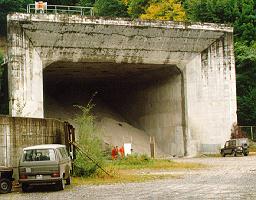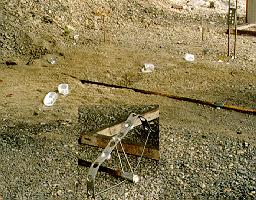

|
|
|
One principal difficulty land mine clearance must cope with is the diversity of mines. Land mines can target either vehicles, principally tanks, or people. I will concentrate exclusively antipersonnel mines, since they represent the overwhelming majority. Further, anti-tank mines are generally designed so that the weight of a person will not detonate them, and being larger and heavier than antipersonnel mines, are correspondingly easier to locate. In fact, a frequent military application of antipersonnel mines is to deter and impede anti-tank mine clearance.
Of the more than 700 types of known antipersonnel mines, the most common is the blast mine. It is buried at a shallow depth in the soil, rarely deeper than 10 cm, and triggered by the pressure of a footstep. The trigger requires a minimum weight of about 5 kg so as not to be set off by small animals, but many of these mines are crudely constructed and deteriorate in the ground so one cannot predict the conditions which will cause them to explode. The square wooden box PMD-6, encountered frequently in Cambodia, can spontaneously explode or be triggered by a very slight pressure as the wood rots and components shift.
A blast mine typically injures only the person who steps on it, resulting in the amputation of a leg. Since many proposals for mine clearance involve means to detonate mines in place, I'd like to give you a sense of the magnitude of the explosions we're talking about.

At this point in the session I played a video of detonations of various amounts of high explosive conducted at the Swiss Army proving ground at Thun, Switzerland on 20th September 1996 in order to measure blast, sand and gravel dispersal effects, and test attenuation of these by various water-filled devices. The movies were made in 1996; due to Web bandwidth limitations at the time, they were made as 192×144 pixel thumbnails. No larger versions are available. The perturbations seen on the videos are due to the effects of the shock wave on the tape transit mechanism of the analogue camcorder used to record them.
25 grams of high explosive. This is representative of the low end of scatterable mine charges.
Swiss Army issue antipersonnel mine with 100 grams of high explosive. Detonation was triggered by an experimental device intended for in-place destruction of buried mines. Unfortunately, the autofocus of the camcorder used to make this movie spent most of the time focused on cracks in the armoured window though which it was aimed.
110 grams of high explosive. This shot served to verify that the detonation effects of electrically-fired plastique explosive were comparable to those of a pressure-triggered blast mine. Confirming this allowed using the much safer plastique for all subsequent tests. A water bottle and wooden pole were placed near the detonation to test their survivability as components of an experimental robot wheel.
110 grams of high explosive fired under the experimental robot wheel assembly. Only a quarter wheel was built for the experiment.



The wheel had an aluminium rim with water-filled PET bottles forming the tire and a wooden pole as the axle. This device was blown to smithereens by the explosion and was not judged to be a promising design.
250 grams of high explosive. This represents the high end of the blast mine range.
250 grams of high explosive buried in gravel. Impact effects of dispersed gravel were measured at various distances from the detonation. Ejecta can be seen knocking over an empty PET bottle (debris from the experimental wheel) in the foreground.
250 grams of high explosive buried in gravel, with a garbage bag filled with water on top. Impacts on panels were compared with the previous shot to evaluate the effectiveness of water in minimising the damage from in-place detonation of mines. Fragments of the garbage bag can be seen falling to the ground after the detonation.